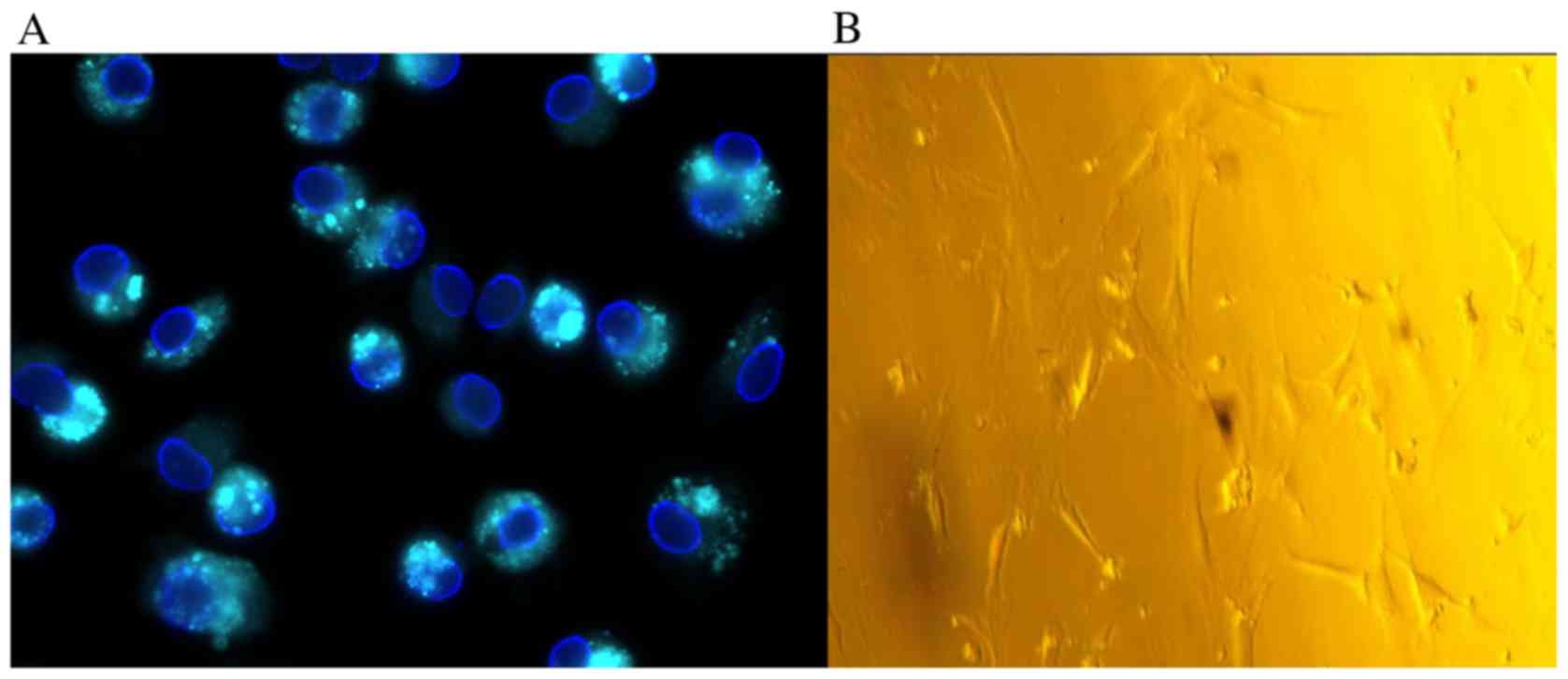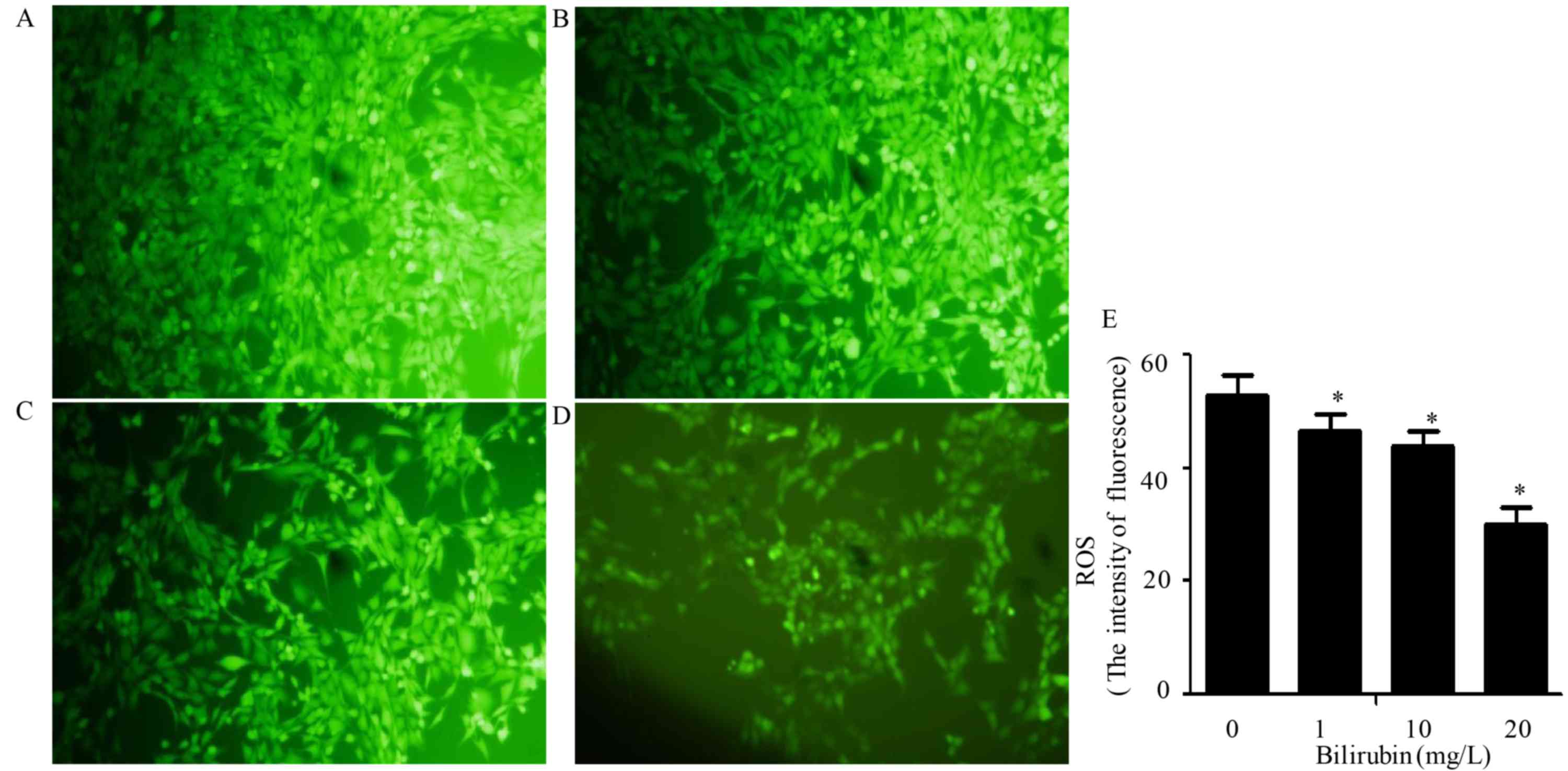|
1
|
Geerts A: History, heterogeneity,
developmental biology, and functions of quiescent hepatic stellate
cells. Semin Liver Dis. 21:311–335. 2001. View Article : Google Scholar : PubMed/NCBI
|
|
2
|
Brandão DF, Ramalho LN, Ramalho FS,
Zucoloto S, Martinelli Ade L and Silva Ode C: Liver cirrhosis and
hepatic stellate cells. Acta Cir Bras. 21 Suppl 1:S54–S57. 2006.
View Article : Google Scholar
|
|
3
|
Li JT, Liao ZX, Ping J, Xu D and Wang H:
Molecular mechanism of hepatic stellate cell activation and
antifibrotic therapeutic strategies. J Gastroenterol. 43:419–428.
2008. View Article : Google Scholar : PubMed/NCBI
|
|
4
|
Atzori L, Poli G and Perra A: Hepatic
stellate cell: A star cell in the liver. Int J Biochem Cell Biol.
41:1639–1642. 2009. View Article : Google Scholar : PubMed/NCBI
|
|
5
|
Tomaro ML and Batlle AM: Bilirubin: Its
role in cytoprotection against oxidative stress. Int J Biochem Cell
Biol. 34:216–220. 2002. View Article : Google Scholar : PubMed/NCBI
|
|
6
|
Washington K, Wright K, Shyr Y, Hunter EB,
Olson S and Raiford DS: Hepatic stellate cell activation in
nonalcoholic steatohepatitis and fatty liver. Hum Pathol.
31:822–828. 2000. View Article : Google Scholar : PubMed/NCBI
|
|
7
|
Stocker R, Yamamoto Y, McDonagh AF, Glazer
AN and Ames BN: Bilirubin is an antioxidant of possible
physiological importance. Science. 235:1043–1046. 1987. View Article : Google Scholar : PubMed/NCBI
|
|
8
|
Wu TW, Fung KP, Wu J, Yang CC and Weisel
RD: Antioxidation of human low density lipoprotein by unconjugated
and conjugated bilirubins. Biochem Pharmacol. 51:859–862. 1996.
View Article : Google Scholar : PubMed/NCBI
|
|
9
|
Yamaguchi T, Horio F, Hashizume T, Tanaka
M, Ikeda S, Kakinuma A and Nakajima H: Bilirubin is oxidized in
rats treated with endotoxin and acts as a physiological antioxidant
synergistically with ascorbic acid in vivo. Biochem Biophys Res
Commun. 214:11–19. 1995. View Article : Google Scholar : PubMed/NCBI
|
|
10
|
Hansen TW: Bilirubin production,
breast-feeding and neonatal jaundice. Acta Paediatr. 90:716–717.
2001. View Article : Google Scholar : PubMed/NCBI
|
|
11
|
Gitto E, Reiter RJ, Karbownik M, Tan DX,
Gitto P, Barberi S and Barberi I: Causes of oxidative stress in the
pre- and perinatal period. Biol Neonate. 81:146–157. 2002.
View Article : Google Scholar : PubMed/NCBI
|
|
12
|
Bataller R, Schwabe RF, Choi YH, Yang L,
Paik YH, Lindquist J, Qian T, Schoonhoven R, Hagedorn CH, Lemasters
JJ and Brenner DA: NADPH oxidase signal transduces angiotensin II
in hepatic stellate cells and is critical in hepatic fibrosis. J
Clin Invest. 112:1383–1394. 2003. View
Article : Google Scholar : PubMed/NCBI
|
|
13
|
Zhong Z, Froh M, Wheeler MD, Smutney O,
Lehmann TG and Thurman RG: Viral gene delivery of superoxide
dismutase attenuates experimental cholestasis-induced liver
fibrosis in the rat. Gene Ther. 9:183–191. 2002. View Article : Google Scholar : PubMed/NCBI
|
|
14
|
Ahmad A and Ahmad R: Resveratrol mitigate
structural changes and hepatic stellate cell activation in
N'-nitrosodimethylamine-induced liver fibrosis via restraining
oxidative damage. Chem Biol Interact. 221:1–12. 2014. View Article : Google Scholar : PubMed/NCBI
|
|
15
|
Yu FX, Teng YY, Zhu QD, Zhang QY and Tang
YH: Inhibitory effects of capsaicin on hepatic stellate cells and
liver fibrosis. Biochem Cell Biol. 92:406–412. 2014. View Article : Google Scholar : PubMed/NCBI
|
|
16
|
Yu F, Su L, Ji S, Zhang S, Yu P, Zheng Y
and Zhang Q: Inhibition of hepatic stellate cell activation and
liver fibrosis by fat-specific protein 27. Mol Cell Biochem.
369:35–43. 2012. View Article : Google Scholar : PubMed/NCBI
|
|
17
|
Elsharkawy AM, Oakley F and Mann DA: The
role and regulation of hepatic stellate cell apoptosis in reversal
of liver fibrosis. Apoptosis. 10:927–939. 2005. View Article : Google Scholar : PubMed/NCBI
|
|
18
|
Choi SS, Sicklick JK, Ma Q, Yang L, Huang
J, Qi Y, Chen W, Li YX, Goldschmidt-Clermont PJ and Diehl AM:
Sustained activation of Rac1 in hepatic stellate cells promotes
liver injury and fibrosis in mice. Hepatology. 44:1267–1277. 2006.
View Article : Google Scholar : PubMed/NCBI
|
|
19
|
McCarty MF, Barroso-Aranda J and Contreras
F: Genistein and phycocyanobilin may prevent hepatic fibrosis by
suppressing proliferation and activation of hepatic stellate cells.
Med Hypotheses. 72:330–332. 2009. View Article : Google Scholar : PubMed/NCBI
|
|
20
|
Jiang F, Roberts SJ, Datla Sr and Dusting
GJ: NO modulates NADPH oxidase function via heme oxygenase-1 in
human endothelial cells. Hypertension. 48:950–957. 2006. View Article : Google Scholar : PubMed/NCBI
|
|
21
|
Kikuchi G, Yoshida T and Noguchi M: Heme
oxygenase and heme degradation. Biochem Biophys Res Commun.
338:558–567. 2005. View Article : Google Scholar : PubMed/NCBI
|
|
22
|
Li L, Grenard P, Nhieu JT, Julien B,
Mallat A, Habib A and Lotersztajn S: Heme oxygenase-1 is an
antifibrogenic protein in human hepatic myofibroblasts.
Gastroenterology. 125:460–469. 2003. View Article : Google Scholar : PubMed/NCBI
|
|
23
|
Tsui TY, Lau CK, Ma J, Glockzin G, Obed A,
Schlitt HJ and Fan ST: Adeno-associated virus-mediated heme
oxygenase-1 gene transfer suppresses the progression of
micronodular cirrhosis in rats. World J Gastroenterol.
12:2016–2023. 2006. View Article : Google Scholar : PubMed/NCBI
|
|
24
|
Lanone S, Bloc S, Foresti R, Almolki A,
Taillé C, Callebert J, Conti M, Goven D, Aubier M, Dureuil B, et
al: Bilirubin decreases nos2 expression via inhibition of NAD(P)H
oxidase: Implications for protection against endotoxic shock in
rats. FASEB J. 19:1890–1892. 2005.PubMed/NCBI
|















